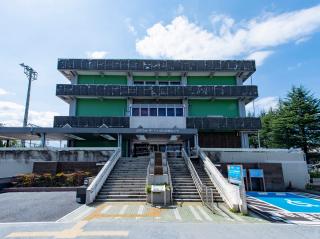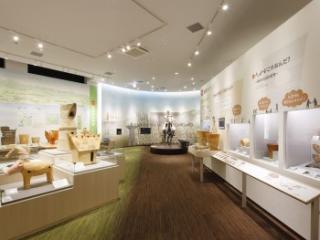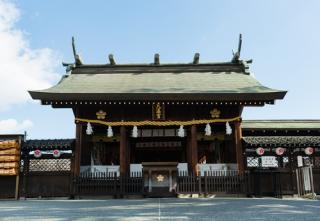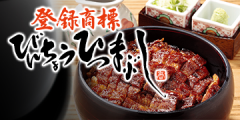- Home
- Sightseeing Spots
Sightseeing Spots
1 - 18 / 18 RESULTS
-

Northern Area
Nagoya Castle
In 1610, Tokugawa Ieyasu began the construction of Nagoya Castle, as a residence for his son Yoshinao. The castle burned down in the war, but in 1959, the five-story main tower keep (approx. 48 meters), with its golden shachi ornaments, and the sub tower keep (approx. 24 meters) were reconstructed. The Nagoya Omotenashi Bushotai greet visitors every day at the main gate, and were the reason behind the bushotai boom across the nation. They also put on an omotenashi performance on weekends and national holidays. In addition, Hommaru Palace was fully opened to the public on June 8, 2018, after the completion of reconstruction work that had taken over 10 years. See More
In 1610, Tokugawa Ieyasu began the construction of Nagoya Castle, as a residence for his son Yoshinao. The castle burned down in …See More
-

Northern Area
Metawater Nagoya Sewerage Science Museum
In 2020, the Metawater Nagoya Sewerage Science Museum underwent a renewal, transforming into an even more captivating facility with an increase in interactive games and models. It now offers a wide range of experiences for visitors. The museum serves as a public relations facility to help people of all ages, from children to adults, easily understand the mechanisms and significance of the sewerage system, which plays a crucial role in citizens' daily lives. By incorporating interactive games and models, the museum has made the sewerage system more easily understandable and enjoyable for visitors to learn about while having fun. See More
In 2020, the Metawater Nagoya Sewerage Science Museum underwent a renewal, transforming into an even more captivating facility wi…See More
-

Northern Area
Hitsuji Shrine
The name of the shrine, Hitsuji Jinja is derived from a historical connection to a person called Hitsuji Taif), who was the lord of the Hitsuji clan. According to the inscriptions on the "Tago-hi" monument in Yoshii Town, Tano District, Gunma Prefecture (now part of Takasaki City, Yoshii Town), Hitsuji Taifu used to stop at a residence in this area (currently located in Nagoya City, Kita Ward, Tsuji-cho) during his journey to the capital in Nara. The people of this land wished for peaceful living, and thus, Hitsuji Taifu enshrined the deity of fire, leading to the shrine being called Hitsuji Jinja - the shrine where Hitsuji Taifu prayed for tranquility in people's hearts. The location of Tsuji-cho, where the shrine is situated, is described in the historical document of Owari Province as "Now, the village is called Tsuji, but it used to be known as 'Hinotsuji,' referring to its ass… See More
The name of the shrine, Hitsuji Jinja is derived from a historical connection to a person called Hitsuji Taif), who was the lor…See More
-

Northern Area
Seimei Shrine
A shrine dedicated to Abe no Seimei, an onmyoji (a practitioner of Japanese esoteric cosmology) from the Heian period. According to tradition, Abe no Seimei once resided in a hermitage in this vicinity. In the past, the area was abundant with marshes and was plagued by "mamushi" (venomous snakes), but it is said that Abe no Seimei performed prayers to confront these challenges, leading to the construction of this shrine in this location. Even today, the shrine continues to attract believers from all over the country as a place of protection against evil spirits and calamities. See More
A shrine dedicated to Abe no Seimei, an onmyoji (a practitioner of Japanese esoteric cosmology) from the Heian period. According …See More
-

Northern Area
tonarino
This is the first commercial complex within a park in Nagoya, created in the northern area of Meijo Park on April 27, 2017. With the concept of Meijo Park growing as it develops together with its parkgoers, the complex was named "tonarino" (roughly meaning "next to") , imagining the idea of the complex being "next to the castle and next to you." Using the four keywords of "cuisine," "bodily health," "green," and "gatherings," places such as a running station, athletic facilities, cafes and restaurants are featured. See More
This is the first commercial complex within a park in Nagoya, created in the northern area of Meijo Park on April 27, 2017. With…See More
-

Northern Area
Muneharu Zone of Kinshachi Yokocho
This is one of the commercial establishments to open in two areas of the Nagoya Castle premises on March 29, 2018. The Muneharu Zone, situated in the east gate area of Nagoya Castle owes its name to the seventh provincial ruler, Lord Muneharu Tokugawa, and is created with the concepts of modernity and change. The buildings are constructed with large panes of glass in a bright, and modern Japanese style of architecture. The zone is lined with restaurants where you can eat highly creative cuisine from owners active not only in Nagoya, but all of Japan and abroad. Enjoy yourself in Kinshachi Yokocho during your visit to Nagoya Castle. See More
This is one of the commercial establishments to open in two areas of the Nagoya Castle premises on March 29, 2018. The Munehar…See More
-

Northern Area
Yoshinao Zone of Kinshachi Yokocho
This is one of the commercial establishments to open in two areas of the Nagoya Castle premises on March 29, 2018. The Yoshinao Zone, situated in the main gate area of Nagoya Castle owes its name to the first provincial ruler of the Owari Tokugawa clan, Lord Yoshinao Tokugawa, and is created with the concepts of tradition and accuracy. The buildings are constructed in a wooden, purely Japanese style of architecture conjuring thoughts of merchant houses from the Edo period. Well-known restaurants offering the unique food culture of Nagoya cuisine, known as "Nagoya meshi", and long-standing, traditional local restaurants are lined up. You can also purchase Kinshachi Yokocho merchandise and famous items from Nagoya the commercial store so you never forget your great time. Enjoy both dining and shopping in Kinshachi Yokocho during your visit to Nagoya Castle. See More
This is one of the commercial establishments to open in two areas of the Nagoya Castle premises on March 29, 2018. The Yoshina…See More
-

Northern Area
Shidami Kofungun Experience Museum
Approximately 200 tumuli were constructed in Nagoya with a third of them (66) confirmed in Kamishidami, Moriyama-ku; and seven--known as the Shidami Kofungun (Shidami Tumulus Group)--are designated national historic landmarks. The Shidami Kofungun occupies a narrow range of 1.7 km from east to west and 1 km from north to south, consists of tumuli built from the beginning of the Kofun (tumulus) period to its end, and is one of the rarest clusters of tumuli in all of Japan. The Shidami Kofungun Historical Area has been maintained to preserve the tumuli. The Shidami Kofungun Historical Area is something like a true-to-life encyclopedia in which you can actually walk around tumuli seeing their various characteristics and differences by the period they were built such as shape and size. The Shidami Kofungun Experience Museum (known as "SHIDAMU" for short) opens in the Shidami Kofungun H… See More
Approximately 200 tumuli were constructed in Nagoya with a third of them (66) confirmed in Kamishidami, Moriyama-ku; and seven--k…See More
-

Northern Area
Nex Plaza" (Nagoya Expressway Public Relations Information Center)
Facility where both children and adults can have fun while deepening their understanding of the Nagoya Expressway. It introduces the construction and management of the expressway and includes interactive exhibits such as the "Driving Simulation," where visitors can design and experience driving on the expressway. The facility also features detailed construction models, and visitors can book in advance for tours of the traffic control room. See More
Facility where both children and adults can have fun while deepening their understanding of the Nagoya Expressway. It introduces …See More
-

Northern Area
Vantelin Dome Nagoya
This stadium is the home ground of the Chunichi Dragons. Baseball fans can enjoy Dragons matches from regular seats, prime box seats for four people, prime twin seats for two people, and more. The stadium's boxed lunches (tamaben) are also popular. Besides Dragons games, the stadium also hosts exhibitions, concerts, and other events. The goods shop Prisma Club is open even on days when there are no events (closed on Mondays if there is no event). See More
This stadium is the home ground of the Chunichi Dragons. Baseball fans can enjoy Dragons matches from regular seats, prime box se…See More
-

Northern Area
Meijo Park
The collective name for the parks surrounding Nagoya Castle, including Ni-no-Maru, San-no-Maru, and up to the northern public park. It is most often used to refer to the park north of the castle. The park has a wide grassy space surrounding Ofukeike Pond that has a stream running through it, a seasonal garden, Meijo Park Flower Plaza, and other areas besides. There are many seasonal exhibitions and events held, as well as regularly held lectures on flower arranging and other topics, gardening consultations, and more. See More
The collective name for the parks surrounding Nagoya Castle, including Ni-no-Maru, San-no-Maru, and up to the northern public par…See More
-

Northern Area
Ryusenji
Ryusenji Temple is a noted temple called the inner shrine of Atsuta Jingu and has the name of Shoutouzan. Denkyo-daishi (a great teacher of Buddhism) is said to be the founder of this temple. Niomon (Deva Gate) and a wooden statue of Jizobosatsu (the guardian deity of travelers and children) are designated as important cultural properties. In addition, the temple houses several hundreds of Buddhist statues including Batokannon (an image of Kannon which has a human body with the head of a horse) carved by Enku. Shops dealing in hobbyhorses operate on Setsubun (February 3). See More
Ryusenji Temple is a noted temple called the inner shrine of Atsuta Jingu and has the name of Shoutouzan. Denkyo-daishi (a great …See More
-

Northern Area
Yamada Tenmagu Shrine
In 1672, Tokugawa Ietsuna, the 4th shogun, encouraged education and learning. The lord of Owari domain, Tokugawa Mitsutomo, valued education and decided to enshrine Sugawara no Michizane's divine spirit in Yamada, now part of Aichi Prefecture. Yamada Tenmangu Shrine became a guardian deity protecting people from misfortunes and bringing blessings. It was located in the inauspicious direction of Nagoya Castle, making it highly revered. See More
In 1672, Tokugawa Ietsuna, the 4th shogun, encouraged education and learning. The lord of Owari domain, Tokugawa Mitsutomo, value…See More
-

Northern Area
Shonai Ryokuchi Park
A health oriented park that connects people and greenery. Using the Odai Water Reservoir along the Shonai River, this comprehensive park revolves around the theme of "water, greenery, and sunshine." With a central lawn area, it features flower gardens, a rose garden, a bird sanctuary, and more. Facilities like tennis courts, cycling paths, and a skate park are also available. Additionally, the Green Plaza within the park houses a greenhouse and an indoor space for various activities. See More
A health oriented park that connects people and greenery. Using the Odai Water Reservoir along the Shonai River, this comprehens…See More
-

Northern Area
Shirasawa Valley
Shirasawa Valley is an artificial valley where a park and a river have been integrated. It's a precious flowing river within the urban environment, surrounded by abundant greenery. You can enjoy the beauty of the four seasons created by nature to the fullest here. See More
Shirasawa Valley is an artificial valley where a park and a river have been integrated. It's a precious flowing river within the …See More
-

Northern Area
Togokusan Fruits Park
A place of nature and history, Mt. Togoku (198 m) is the tallest mountain in the city, and is surrounded by 70 kofun sites. Togokusan Fruits Park is a multipurpose agricultural park at the base of the mountain that uses the rich natural surroundings. In the park there is an orchard where around 900 trees of 17 species of fruit grow, including peaches, Asian pears, and apples. There is a greenhouse where you can see papaya, jackfruit, and other rare tropical fruits, and a fruithouse where you can see exhibits of various sample fruits. Besides these, the park also has a fishing corner, Japanese-style garden, all-season flower garden, a restaurant, and shops. The park is a famous place for weeping cherry blossom trees in the spring. See More
A place of nature and history, Mt. Togoku (198 m) is the tallest mountain in the city, and is surrounded by 70 kofun sites. Togok…See More
-

Northern Area
Historic Townscapes of Nakaotai
This town was built along the Iwakura Kaido highway, which bustled with life as vegetables were brought from Iwakura to the Fresh Produce Wholesale Market of Biwajima. Townhouses and storehouses remain to this day, and you can feel the history of the highway. See More
This town was built along the Iwakura Kaido highway, which bustled with life as vegetables were brought from Iwakura to the Fresh…See More
-

Northern Area
Nagoya Noh Theater
The world's largest noh theater. Enjoy a mystical world. The building has a refined Japanese-style exterior, as is fitting for occasions such as watching a noh performance. Its defining features are the stage made entirely of Japanese cypress wood, the wooden interior fittings, and the large viewing area with 630 seats. Besides being used for noh, kyogen, and other traditional performing arts, the space is also used for international conferences, lectures, weddings, and so on. There is also a conference room that holds 99 people (with a lecturers' waiting room) and can be used for conferences, training programs, and more. In the exhibition room, there are panel displays and videos that explain the history and charms of noh in a way even beginners can understand, as well as explanations about noh in Nagoya. Admission to the exhibition room is free. Four to five days a month, t… See More
The world's largest noh theater. Enjoy a mystical world. The building has a refined Japanese-style exterior, as is fitting for…See More















